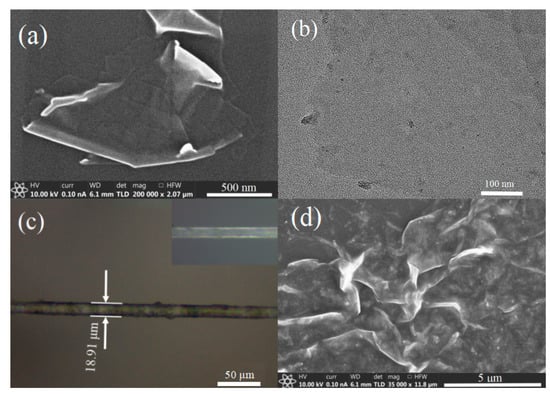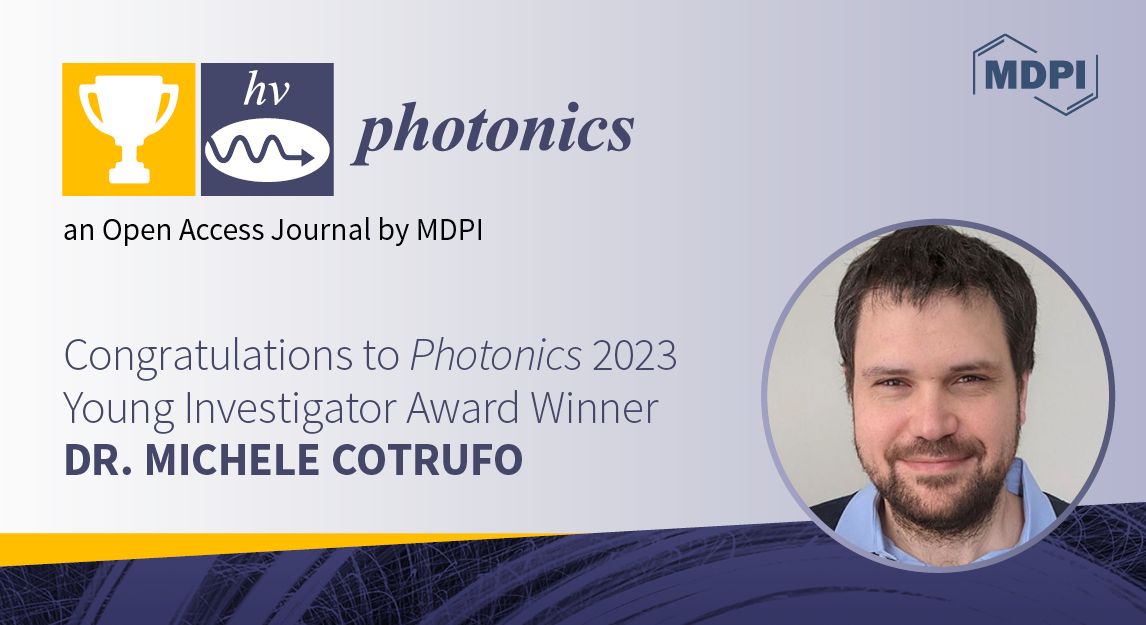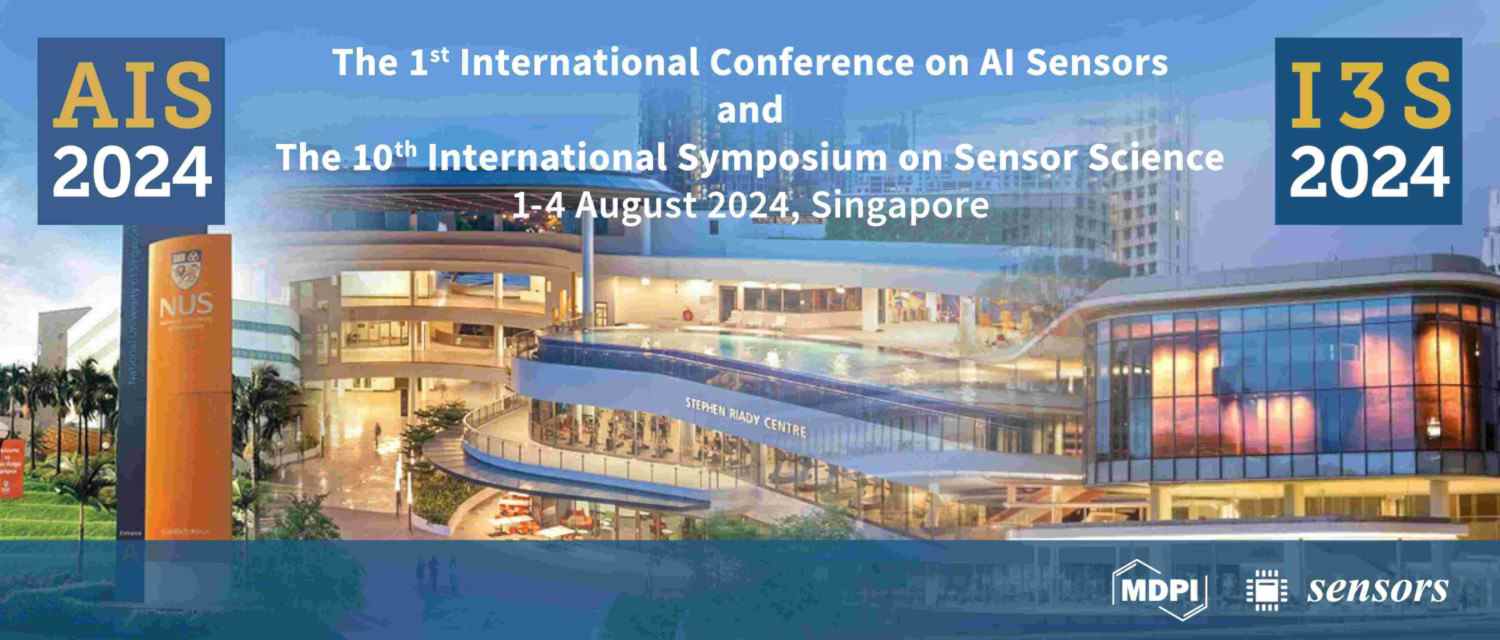Journal Description
Photonics
Photonics
is an international, scientific, peer-reviewed, open access journal on the science and technology of optics and photonics, published monthly online by MDPI.
- Open Access— free for readers, with article processing charges (APC) paid by authors or their institutions.
- High Visibility: indexed within Scopus, SCIE (Web of Science), Inspec, CAPlus / SciFinder, and other databases.
- Rapid Publication: manuscripts are peer-reviewed and a first decision is provided to authors approximately 15.5 days after submission; acceptance to publication is undertaken in 2.7 days (median values for papers published in this journal in the second half of 2023).
- Recognition of Reviewers: reviewers who provide timely, thorough peer-review reports receive vouchers entitling them to a discount on the APC of their next publication in any MDPI journal, in appreciation of the work done.
- Companion journal: Optics.
Impact Factor:
2.4 (2022);
5-Year Impact Factor:
2.4 (2022)
Latest Articles
MXene-Based Fiber-Optic Humidity Sensor for Fast Human Breath Monitoring
Photonics 2024, 11(1), 79; https://doi.org/10.3390/photonics11010079 - 15 Jan 2024
Abstract
Breath is one of the most important physiological features of human life. In particular, it is significant to monitor the physical characteristics of breath, such as breath frequency and tidal volume. Breath sensors play an important role in the field of human health
[...] Read more.
Breath is one of the most important physiological features of human life. In particular, it is significant to monitor the physical characteristics of breath, such as breath frequency and tidal volume. Breath sensors play an important role in the field of human health monitoring. However, an electronic breath sensor is not stable or even safe when the patient is in a Magnetic Resonance Imaging (MRI) system or during any oncology treatment that requires radiation and other high electric/magnetic fields. Fiber-optic-based sensors have attracted a considerable amount of attention from researchers since they are immune to electromagnetic interference. Here, we propose and demonstrate a fiber-optic-based relative-humidity (RH)-sensing strategy by depositing Ti3C2Tx nanosheets onto an etched single-mode fiber (ESMF). The humidity sensor function is realized by modulating the transmitted light in the ESMF using the excellent hydrophilic properties of Ti3C2Tx. Experiments show that the coated Ti3C2Tx nanosheets can effectively modulate the transmitted light in the ESMF in the relative humidity range of 30~80% RH. The sensor’s fast response time of 0.176 s and recovery time of 0.521 s allow it to be suitable for real-time human breath monitoring. The effective recognition of different breath rhythms, including fast, normal, deep, and strong breathing patterns, has been realized. This work demonstrates an all-optical Ti3C2Tx-based sensing platform that combines Ti3C2Tx with an optical fiber for humidity sensing for the first time, which has great promise for breath monitoring and presents novel options for gas-monitoring applications in the biomedical and chemical fields.
Full article
(This article belongs to the Special Issue Advances in Fiber-Optics)
►
Show Figures
Open AccessArticle
The Development of a Remote Edge-Lit Backlight Structure with Blue Laser Diodes
Photonics 2024, 11(1), 78; https://doi.org/10.3390/photonics11010078 - 15 Jan 2024
Abstract
In this study, we introduce a novel design of a remote edge-lit backlight structure featuring blue laser diodes (LDs). These LDs were integrated into a remote yellow phosphor layer on a light guide plate (LGP). Blue light emitted by the LDs passes through
[...] Read more.
In this study, we introduce a novel design of a remote edge-lit backlight structure featuring blue laser diodes (LDs). These LDs were integrated into a remote yellow phosphor layer on a light guide plate (LGP). Blue light emitted by the LDs passes through the LGP and spreads to the remote phosphor layer, generating white light output. Owing to the incorporation of a scattering layer between sequential LGPs, the remote edge-lit backlight structure facilitates the expansion of the output surface of the LGP by combining multiple individual LGPs. Two- and three-LGP remote edge-lit backlight structures demonstrated acceptable white illuminance uniformity. The proposed architecture serves as a viable solution for achieving uniform illumination in planar lighting systems using blue LDs; thus, this structure is particularly suitable for linear lighting or slender backlighting instead of display stand applications.
Full article
(This article belongs to the Special Issue Advanced Lasers and Their Applications)
►▼
Show Figures
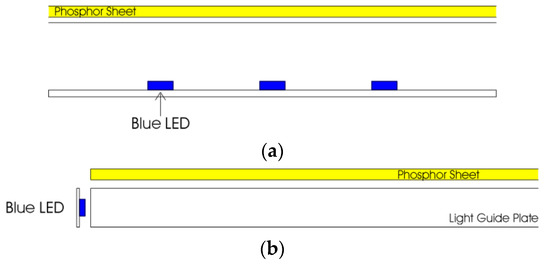
Figure 1
Open AccessArticle
A Novel Eye Hole Method for the Crosstalk Test of Small Element Infrared Focal Plane Arrays
Photonics 2024, 11(1), 77; https://doi.org/10.3390/photonics11010077 - 15 Jan 2024
Abstract
The crosstalk of the small detection photosensitive elements test has always been the difficulty of research on infrared focal plane arrays (IRFPAs). With the decrease in the element size in the IRFPAs, the crosstalk of small detection photosensitive elements cannot be tested by
[...] Read more.
The crosstalk of the small detection photosensitive elements test has always been the difficulty of research on infrared focal plane arrays (IRFPAs). With the decrease in the element size in the IRFPAs, the crosstalk of small detection photosensitive elements cannot be tested by the existing small spot method. In this paper, a novel eye hole method to realize the crosstalk of the small element IRFPAs test is proposed. The novel eye hole method is to make eye holes on the substrate. The transmittance of the eye holes in the substrate is 100%, while the transmittance of the other component in the substrate is 0. The substrate with the eye holes is fixed in front of small element IRFPAs to achieve the crosstalk of the small elements test. The filters selected by 9 elements and 25 elements as the eye hole unit are designed and prepared. The experimental results show that 25 elements are selected as the eye hole unit for the IRFPAs with the element size of 25 μm × 25 μm. The eye holes are formed tightly and repeatedly arranged. The crosstalk of the InSb IRFPAs with the element size of 25 μm × 25 μm by the novel eye hole method is 3.86%. The results are of great reference significance for improving the test level of small element IRFPA.
Full article
(This article belongs to the Special Issue Photodetector Materials and Optoelectronic Devices)
►▼
Show Figures
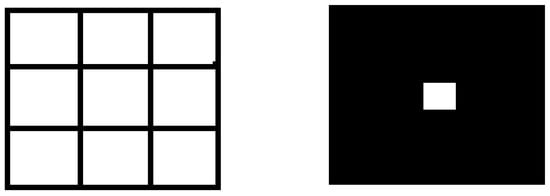
Figure 1
Open AccessArticle
Mueller-Polarimetry of Barley Leaves II: Mueller Matrix Decompositions
Photonics 2024, 11(1), 76; https://doi.org/10.3390/photonics11010076 - 13 Jan 2024
Abstract
This paper highlights the application of decomposition methods in Mueller polarimetry for the discrimination of three groups of barley leaf samples from Hordeum vulgare: Chlorina mutant, Chlorina etiolated mutant and Cesaer varieties in the visible wavelength at λ = 632.8 nm. To
[...] Read more.
This paper highlights the application of decomposition methods in Mueller polarimetry for the discrimination of three groups of barley leaf samples from Hordeum vulgare: Chlorina mutant, Chlorina etiolated mutant and Cesaer varieties in the visible wavelength at λ = 632.8 nm. To obtain the anisotropic and depolarizing properties of the samples under study, the additive and multiplicative decompositions of experimental Mueller matrices were used. We show how a rich set of anisotropy and depolarization parameters obtained from decompositions can be used as effective observables for the discrimination between different varieties of the same plant species.
Full article
(This article belongs to the Special Issue Polarization Optics in Biomedical Applications)
►▼
Show Figures
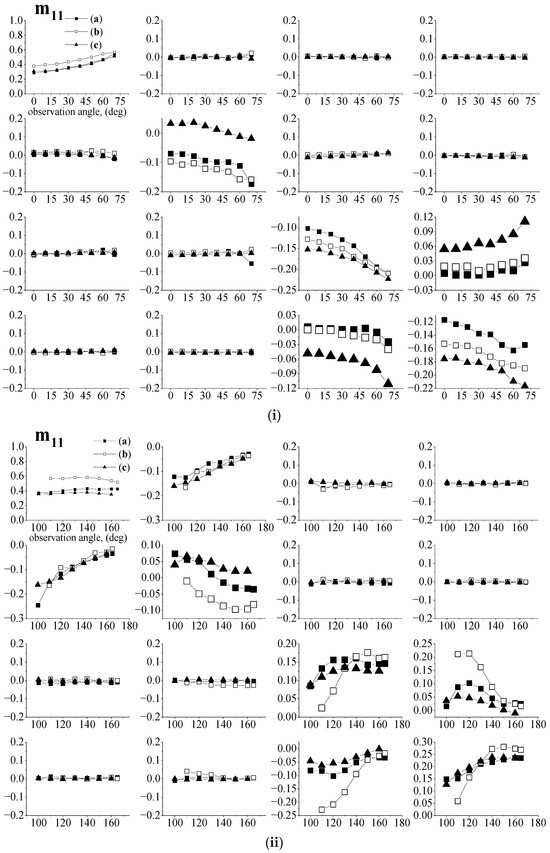
Figure 1
Open AccessArticle
Research on High-Precision Position Detection Based on a Driven Laser Spot in an Extreme Ultraviolet Light Source
Photonics 2024, 11(1), 75; https://doi.org/10.3390/photonics11010075 - 13 Jan 2024
Abstract
►▼
Show Figures
Laser-spot-location detection technology based on photodetectors is widely used in the aerospace, medical, military and communication fields. However, most of the current research focuses on continuous laser detection in the visible and near-infrared bands, and the real-time high-precision position detection of a long-wave
[...] Read more.
Laser-spot-location detection technology based on photodetectors is widely used in the aerospace, medical, military and communication fields. However, most of the current research focuses on continuous laser detection in the visible and near-infrared bands, and the real-time high-precision position detection of a long-wave infrared pulsed laser is lacking. In this paper, a spot-position detection system based on a four-quadrant detector is designed for a 10.6 μm CO2-driven laser in extreme ultraviolet light source, and a second-order extended error compensation algorithm based on a Gaussian-spot model is proposed. Finally, the algorithm is verified and analyzed experimentally by a spot-position detection system under both focusing and defocusing conditions. The experimental results show that the root-mean-square error, maximum absolute error and average absolute error of the second-order error compensation algorithm are significantly reduced compared with the traditional algorithm, and the detection accuracy of the spot-position is better than 9 μm. The above results show that this spot-position detection system has obvious advantages and high accuracy, which can realize the high-precision real-time detection of a laser’s spot position to obtain accurate spot position information, provide feedback adjustments for subsequent beam pointing control, and provide a theoretical basis for the beam pointing stability of the extreme ultraviolet light source system.
Full article

Figure 1
Open AccessArticle
Research on Coherent Stray Light Fringes in Interference Compensation Testing
by
, , , , , , and
Photonics 2024, 11(1), 74; https://doi.org/10.3390/photonics11010074 - 11 Jan 2024
Abstract
Testing accuracy is an essential factor in determining the manufacturing accuracy of aspheric mirrors. Because of the complexity of the null compensation test, the coherent stray lights generated by multiple reflections and transmissions between optical elements and the crosstalk fringes generated by the
[...] Read more.
Testing accuracy is an essential factor in determining the manufacturing accuracy of aspheric mirrors. Because of the complexity of the null compensation test, the coherent stray lights generated by multiple reflections and transmissions between optical elements and the crosstalk fringes generated by the multi-beam interference of the reference light, test light, and stray lights are superimposed on the interference fringes, resulting in reduced testing accuracy. Focusing on this problem, a simulation analysis method for crosstalk fringes based on ray-tracing and multi-beam interference in interference testing is proposed. The coordinates, amplitudes, and phases of the test light and stray lights on the transmission sphere are traced, and the crosstalk fringes and interference testing fringes and their positions, sizes, and intensity information are simulated via multi-beam interference. The influence of crosstalk fringes on interference fringes is determined. An experimental optical path is built to verify the correctness of the crosstalk fringe simulation method.
Full article
(This article belongs to the Special Issue Optical Precision Manufacturing and Processing)
►▼
Show Figures

Figure 1
Open AccessArticle
Geometric-Optical Model of Digital Holographic Particle Recording System and Features of Its Application
Photonics 2024, 11(1), 73; https://doi.org/10.3390/photonics11010073 - 11 Jan 2024
Abstract
►▼
Show Figures
The paper proposes an equivalent optical scheme of an in-line digital holographic system for particle recording and a mathematical model that establishes a one-to-one correspondence between the dimensional and spatial parameters of a digital holographic image of a particle and the imaged particle
[...] Read more.
The paper proposes an equivalent optical scheme of an in-line digital holographic system for particle recording and a mathematical model that establishes a one-to-one correspondence between the dimensional and spatial parameters of a digital holographic image of a particle and the imaged particle itself. The values of the model coefficients used to determine the real size and longitudinal coordinate of a particle according to its holographic image are found by calibration. The model was tested in field and laboratory conditions to calibrate a submersible digital holographic camera designed to study plankton in its habitat. It was shown that four calibration measurements are sufficient enough to determine the model coefficients, and the developed design of the submersible digital holographic camera makes it possible to perform these measurements during the recording of each hologram. In addition, this neither requires data on the refractive index of the medium with particles nor on the parameters of the optical elements of the scheme. The paper presents the results of marine experiments in the Kara Sea and the Laptev Sea, as well as in fresh water in laboratory conditions and in Lake Baikal. The error in measuring the particle size in seawater without the use of the model is 53.8%, while the error in determining their longitudinal coordinates is 79.3%. In fresh water, the same errors were 59% and 54.5%, respectively. The error in determining the position of a particle with the use of the designed mathematical model does not exceed 1.5%, and the error in determining the size is 4.8%. The model is sensitive to changes in the optical properties of the medium, so it is necessary to perform calibration in each water area, and one calibration is quite sufficient within the same water area. At the same time, the developed design of the submersible holographic camera allows, if necessary, calibration at each holographing of the medium volume with particles.
Full article

Figure 1
Open AccessArticle
Study on the Removal Depth of the Surface Plastic Domain of Silicon-Modified Silicon Carbide
Photonics 2024, 11(1), 72; https://doi.org/10.3390/photonics11010072 - 11 Jan 2024
Abstract
Silicon carbide (Sic) materials find wide-ranging applications in advanced optical systems within the aerospace, astronomical observation, and high-intensity laser fields. The silicon-modified Sic used in this study was created by depositing an amorphous silicon film on the surface of a Sic substrate using
[...] Read more.
Silicon carbide (Sic) materials find wide-ranging applications in advanced optical systems within the aerospace, astronomical observation, and high-intensity laser fields. The silicon-modified Sic used in this study was created by depositing an amorphous silicon film on the surface of a Sic substrate using electron beam evaporation. Such hard and brittle materials often yield smooth surfaces when subjected to plastic removal. To address the issue of the removal depth of the surface plastic domain for silicon-modified Sic, we propose a method to calculate the indentation depth based on the critical load for the transition from plastic to brittle removal. We conducted a series of nanoindentation and nanoscratching experiments. The critical depth formula was validated through mechanical parameters such as hardness, elastic modulus, and fracture toughness, and the theoretical critical depth of the modified silicon layer was calculated to be 2.71 μm. The research results indicate that the critical load for obtaining the plastic-to-brittle transition point during the nanoindentation experiment is 886 mN, at which point the depth of plastic removal is 2.95 μm, closely matching the theoretical value. The measurements taken with an atomic force microscope near the critical load reveal a scratch depth of 3.12 μm, with a relative error of less than 5% when compared to the calculated value. This study establishes a solid foundation for achieving high-quality surface processing.
Full article
(This article belongs to the Special Issue Optical Precision Manufacturing and Processing)
►▼
Show Figures
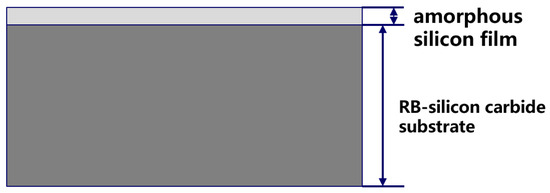
Figure 1
Open AccessArticle
Complex Noise-Based Phase Retrieval Using Total Variation and Wavelet Transform Regularization
Photonics 2024, 11(1), 71; https://doi.org/10.3390/photonics11010071 - 10 Jan 2024
Abstract
This paper presents a phase retrieval algorithm that incorporates sparsity priors into total variation and framelet regularization. The proposed algorithm exploits the sparsity priors in both the gradient domain and the spatial distribution domain to impose desirable characteristics on the reconstructed image. We
[...] Read more.
This paper presents a phase retrieval algorithm that incorporates sparsity priors into total variation and framelet regularization. The proposed algorithm exploits the sparsity priors in both the gradient domain and the spatial distribution domain to impose desirable characteristics on the reconstructed image. We utilize structured illuminated patterns in holography, consisting of three light fields. The theoretical and numerical analyses demonstrate that when the illumination pattern parameters are non-integers, the three diffracted data sets are sufficient for image restoration. The proposed model is solved using the alternating direction multiplier method. The numerical experiments confirm the theoretical findings of the lighting mode settings, and the algorithm effectively recovers the object from Gaussian and salt–pepper noise.
Full article
(This article belongs to the Section Optical Communication and Network)
►▼
Show Figures
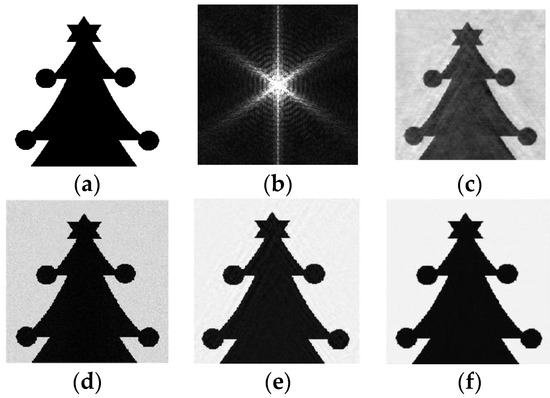
Figure 1
Open AccessArticle
A Concise and Adaptive Sidelobe Suppression Algorithm Based on LMS Filter for Pulse-Compressed Signal of Φ-OTDR
by
, , , , , , , and
Photonics 2024, 11(1), 70; https://doi.org/10.3390/photonics11010070 - 08 Jan 2024
Abstract
A concise and adaptive sidelobe suppression algorithm based on a least mean square (LMS) filter is proposed for pulse-compressed signals of a phase-sensitive optical time-domain reflectometer (Φ-OTDR) system. The algorithm is suitable for the denoising filtering process of phase coding OTDR (PC-OTDR) systems
[...] Read more.
A concise and adaptive sidelobe suppression algorithm based on a least mean square (LMS) filter is proposed for pulse-compressed signals of a phase-sensitive optical time-domain reflectometer (Φ-OTDR) system. The algorithm is suitable for the denoising filtering process of phase coding OTDR (PC-OTDR) systems and mitigates the sidelobe effect due to matched filtering. In a simulation experiment, Rayleigh backscattering (RBS) signals including phase-coded pulse signals are generated and decoded to verify that the LMS algorithm can eliminate the sidelobes more effectively than the windowing method and the recursive least squares (RLS) method. Then, the PC-OTDR system is set up and combined with the LMS algorithm for positioning experiments. The results show that the peak side lobe ratio (PSLR) of the signals can reach −15.86 dB, which is 4.26 dB lower than the raw pulse compressed signal.
Full article
(This article belongs to the Topic Advance and Applications of Fiber Optic Measurement: 2nd Edition)
►▼
Show Figures

Figure 1
Open AccessArticle
Dual-Polarized Reconfigurable Manipulation Based on Flexible-Printed Intelligent Reflection Surface
Photonics 2024, 11(1), 69; https://doi.org/10.3390/photonics11010069 - 08 Jan 2024
Abstract
►▼
Show Figures
In the background of 6G communication requiring a high data rate and energy efficiency, global coverage and connectivity, as well as high reliability and low latency, most existing reconfigurable metasurfaces face limitations in flexibility, integrability, energy consumption, and cost. This paper proposes a
[...] Read more.
In the background of 6G communication requiring a high data rate and energy efficiency, global coverage and connectivity, as well as high reliability and low latency, most existing reconfigurable metasurfaces face limitations in flexibility, integrability, energy consumption, and cost. This paper proposes a dual-polarized intelligent reflection surface (IRS) based on a paper-based flexible substrate as a solution. The proposed design uniquely enables the independent control of two orthogonally polarized electromagnetic waves to achieve customized scattering effects. Compared to conventional reconfigurable intelligent surfaces using PCB technology and active components, this design utilizes paper as the substrate material combined with conductive ink and silver ink, significantly reducing production costs and process complexity. The manufacturing cost is only about one-tenth of the traditional PCB solutions. This approach is not only cost-effective but also excels in both flexibility and portability. These attributes signify its suitability for a broader range of potential applications, encompassing areas where traditional RIS may be impractical due to cost, rigidity, or complexity constraints. By drawing rotationally symmetric small metal block structures on paper using silver ink, four structures are designed that achieve a phase difference of 90 degrees for both x-polarized and y-polarized wave incidences at the resonant frequency of 4.5754 GHz, realizing independent phase modulation. The dual-polarized flexible 2-bit intelligent reflection surface consists of
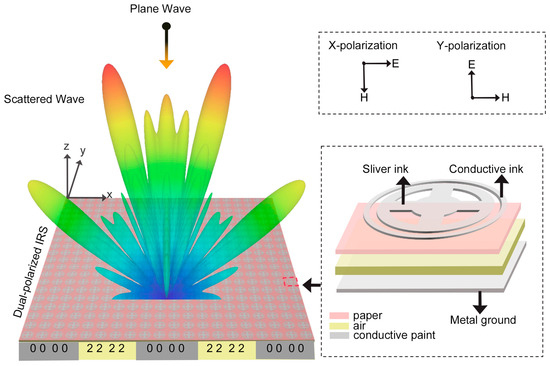
Figure 1
Open AccessArticle
Investigation of Multiple High Quality-Factor Fano Resonances in Asymmetric Nanopillar Arrays for Optical Sensing
by
, , , , , , , , , and
Photonics 2024, 11(1), 68; https://doi.org/10.3390/photonics11010068 - 08 Jan 2024
Abstract
A novel asymmetric all-dielectric metasurface supporting multiple Fano resonances with high quality-factor through the excitation of quasi-bound states in the continuum is theoretically investigated. It is demonstrated that two resonances in the near-infrared wavelength are excited by the symmetry-protected bound state in the
[...] Read more.
A novel asymmetric all-dielectric metasurface supporting multiple Fano resonances with high quality-factor through the excitation of quasi-bound states in the continuum is theoretically investigated. It is demonstrated that two resonances in the near-infrared wavelength are excited by the symmetry-protected bound state in the continuum, which can be transformed into the electric dipole and the toroidal dipole quasi-BIC resonance with high quality-factor by breaking the symmetry of metasurface. Moreover, the sensing properties based on different liquid refractive indexes are researched theoretically. The results show that the maximum quality-factor of the Fano resonance peak is 8422, and the sensitivity can reach 402 nm/RIU, with a maximum figure of merit of 2400 RIU−1. This research is believed to further promote the development of optical sensing and nonlinear optics.
Full article
(This article belongs to the Special Issue Editorial Board Members’ Collection Series: Photonics Sensors)
►▼
Show Figures

Figure 1
Open AccessArticle
Multi-Array Visible-Light Optical Generalized Spatial Multiplexing–Multiple Input Multiple-Output System with Pearson Coefficient-Based Antenna Selection
Photonics 2024, 11(1), 67; https://doi.org/10.3390/photonics11010067 - 08 Jan 2024
Abstract
To address the limitations of poor environmental adaptability, unsatisfactory bit-error performance, and high complexity of conventional antenna selection algorithms applied to a multi-array visible-light optical generalized spatial multiplexing–multiple-input multiple-output (OGSMP-MIMO) system, an OGSMP-MIMO system based on Pearson coefficient antenna selection is proposed. The
[...] Read more.
To address the limitations of poor environmental adaptability, unsatisfactory bit-error performance, and high complexity of conventional antenna selection algorithms applied to a multi-array visible-light optical generalized spatial multiplexing–multiple-input multiple-output (OGSMP-MIMO) system, an OGSMP-MIMO system based on Pearson coefficient antenna selection is proposed. The algorithm adopts the correlation of Pearson coefficients among photoelectric detector (PD) terminals at different positions and active transmit antennas to select the optimal antenna combination without relying on the accuracy of channel estimation, for realizing the multiplexing of the time and space domains, and to improve the bit-error performance. Finally, experiments were conducted to verify the feasibility of the antenna selection algorithm, based on the Pearson coefficients. The results indicated that when the bit-error rate reached 10−6, using the antenna selection algorithm based on the Pearson coefficient, the signal-to-noise ratio was improved by 2.7 dB and 3.7 dB when compared with the norm-based antenna and random selection algorithms, respectively. In addition, increasing the number of active transmitting antennas can improve the transmission rate; however, the bit-error performance will be compromised. In the same modulation mode, increasing the number of transmitting antennas will reduce the bit-error performance.
Full article
(This article belongs to the Special Issue Application of Adaptive Optics Theory and Technology in Optical Wireless Communication)
►▼
Show Figures
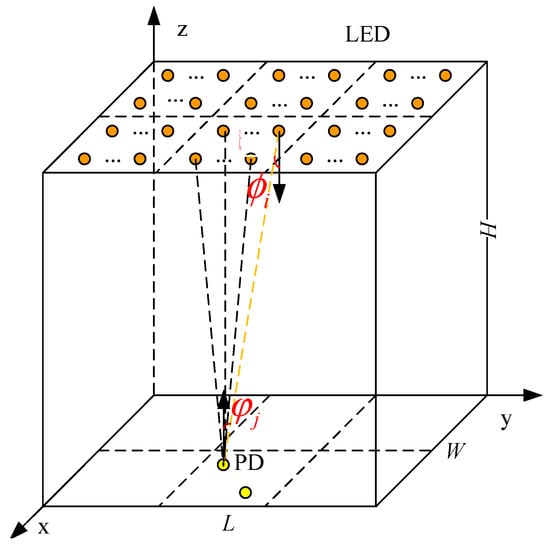
Figure 1
Open AccessArticle
An Experimental Determination of Critical Power for Self-Focusing of Femtosecond Pulses in Air Using Focal-Spot Measurements
by
, , , , , , and
Photonics 2024, 11(1), 66; https://doi.org/10.3390/photonics11010066 - 08 Jan 2024
Abstract
The filamentation of femtosecond pulses has attracted significant attention, owing to its unique characteristics and related applications. The self-focusing critical power of femtosecond pulses is one of the key parameters in the filamentation process and its application. However, the experimental determination of this
[...] Read more.
The filamentation of femtosecond pulses has attracted significant attention, owing to its unique characteristics and related applications. The self-focusing critical power of femtosecond pulses is one of the key parameters in the filamentation process and its application. However, the experimental determination of this power remains a challenging task. In this study, we propose an experimental approach to investigating the critical power for self-focusing of both femtosecond Gaussian and vortex beams with relatively low topological charges by analyzing the changes in the focal spot at different propagation distances. Our work offers a practical and convenient method for determining the self-focusing critical power of femtosecond pulses.
Full article
(This article belongs to the Special Issue Ultrafast Intense Laser Filamentation and Beyond)
►▼
Show Figures

Figure 1
Open AccessArticle
Reconfigurable Microwave Multi-Beamforming Based on Optical Switching and Distributing Network
Photonics 2024, 11(1), 65; https://doi.org/10.3390/photonics11010065 - 07 Jan 2024
Abstract
Optical beamforming in microwave photonics is promising for supporting broadband wireless communications. However, the current optical beamforming lacks freedom because of the fixed connection between radio frequency (RF) signal and antenna elements (AEs). This manuscript tackles this challenge by proposing a dynamical optical
[...] Read more.
Optical beamforming in microwave photonics is promising for supporting broadband wireless communications. However, the current optical beamforming lacks freedom because of the fixed connection between radio frequency (RF) signal and antenna elements (AEs). This manuscript tackles this challenge by proposing a dynamical optical beamforming architecture that reconfigures the antenna subarray for signal transmission depending on the number of signals to be transmitted. The proposed architecture employs an optical switching and distributing network (SDN) to realize a flexible connection between signals and AEs. An instance of the proposed architecture in photonic integrated circuits, which enables three working modes and transmits four RF signals through sixteen AEs, was presented and numerically simulated. The optical field distribution and beam pattern plots illustrated the operational principle and validated the feasibility of the proposed SDN architecture. Furthermore, the impact of the introduced architecture on the signal amplitude–phase consistency and the comparison of the proposed dynamic architecture and conventional fixe architectures are analyzed and discussed. The results indicate that the proposed architecture exhibits variable beamforming gain with lower hardware complexity.
Full article
(This article belongs to the Special Issue The Development and Future Prospect of Microwave Photonics)
►▼
Show Figures
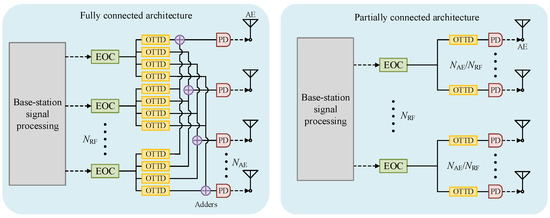
Figure 1
Open AccessArticle
The Propagation Characteristics of Circular Airy Beams with Propagational Fractional-Order Optical Vortices
Photonics 2024, 11(1), 64; https://doi.org/10.3390/photonics11010064 - 07 Jan 2024
Abstract
►▼
Show Figures
We investigate the propagation properties of circular Airy beams (CABs) with propagational fractional-order optical vortices (OVs). The superposition of the phase singularity and polarization singularity from a vortex vector beam (VVB) plays a significant role in creating a propagational fractional vortex beam. Propagational
[...] Read more.
We investigate the propagation properties of circular Airy beams (CABs) with propagational fractional-order optical vortices (OVs). The superposition of the phase singularity and polarization singularity from a vortex vector beam (VVB) plays a significant role in creating a propagational fractional vortex beam. Propagational fractional vortex beams can be considered as a superposition of left and right circularly polarized vortex beams with different integer topological charges (TCs). We study the propagation characteristics of two kinds of propagational fractional vortex CABs, and the results show that both of the two kinds of beams can stably propagate in free space, and they exhibit an “abruptly auto-focusing” property and “self-healing” property during the propagation. The intensity distribution of the first kind of propagational fractional vortex CAB has an odd number of petals (2m + 1), while the second kind of beam has a crescent-shaped intensity distribution. The influence of turbulence on the beam propagation through atmosphere under different turbulence strengths is also numerically studied in this paper. A fractional vortex CAB with an initial radius r0 = 10 mm can retain its shape after propagating 20 m when the atmospheric refractive-index structure constant
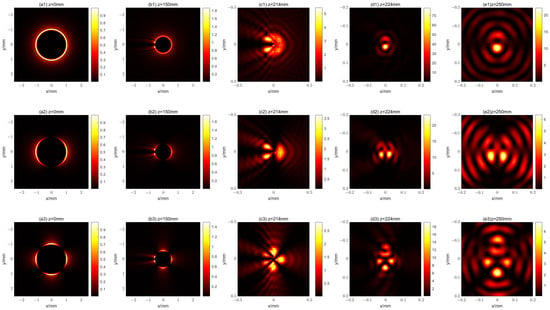
Figure 1
Open AccessArticle
Optical Filter Design for Daylight Outdoor Electroluminescence Imaging of PV Modules
by
and
Photonics 2024, 11(1), 63; https://doi.org/10.3390/photonics11010063 - 07 Jan 2024
Abstract
This paper presents an advanced outdoor electroluminescence (EL) imaging system for inspecting solar photovoltaic (PV) modules under varying daylight conditions. EL imaging, known for its effectiveness in non-destructively detecting PV module defects, is enhanced through specialized optical filters. These filters, including a bandpass
[...] Read more.
This paper presents an advanced outdoor electroluminescence (EL) imaging system for inspecting solar photovoltaic (PV) modules under varying daylight conditions. EL imaging, known for its effectiveness in non-destructively detecting PV module defects, is enhanced through specialized optical filters. These filters, including a bandpass filter targeting EL emissions and a neutral density filter to reduce background light, significantly improve the system’s signal-to-noise ratio (SNR). The experimental results demonstrate the system’s enhanced performance, with superior clarity and detail in EL emissions, enabling precise defect localization and characterization at the cellular level. Notably, the system achieves an SNR improvement, with values consistently above two, outperforming previous systems and confirming its suitability for efficient solar PV maintenance and diagnostics. This research offers a flexible approach to optimizing EL imaging quality across various solar irradiance levels and angles, essential for improved PV module performance and reliability. The system effectively handles different PV module configurations, orientations, and types, including monofacial and bifacial arrays. It showcases robust imaging capabilities under high solar irradiance and different sun illumination levels, maintaining high-quality imaging due to its optimized filter design. Additionally, the system’s adaptability in detecting EL emissions from series-connected PV modules is highlighted, demonstrating its comprehensive evaluation capabilities for PV array performance.
Full article
(This article belongs to the Special Issue Optical Spectroscopy and Applications)
►▼
Show Figures
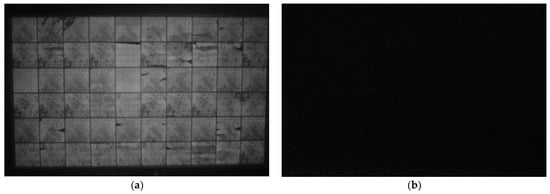
Figure 1
Open AccessArticle
Efficient Cherenkov-Type Optical-to-Terahertz Conversion of Femtosecond Oscillator Pulses
Photonics 2024, 11(1), 62; https://doi.org/10.3390/photonics11010062 - 06 Jan 2024
Abstract
We demonstrate experimentally that a recently proposed structure comprising a tens of microns thick layer of LiNbO
We demonstrate experimentally that a recently proposed structure comprising a tens of microns thick layer of LiNbO
(This article belongs to the Section Lasers, Light Sources and Sensors)
►▼
Show Figures
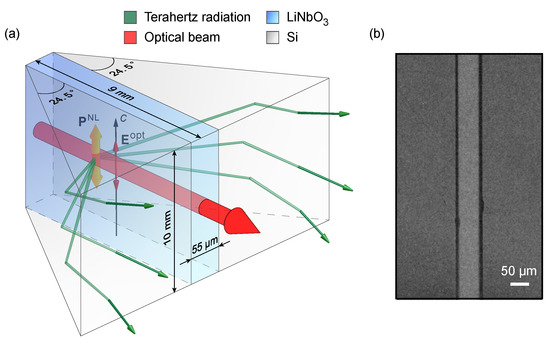
Figure 1
Open AccessArticle
Sub-Nanosecond, High Peak Power Yb:YAG/Cr4+:YAG/YVO4 Passively Q-Switched Raman Microchip Laser with the Emission of Multiple Pulses
Photonics 2024, 11(1), 61; https://doi.org/10.3390/photonics11010061 - 05 Jan 2024
Abstract
This paper demonstrates the capability of sub-nanosecond, high peak power Yb:YAG/Cr4+:YAG/YVO4 passively Q-switched Raman microchip lasers at 1134 nm operated in multiple pulses mode under quasi-continuous-wave (QCW) pumping. Total pulse energy for the Stokes laser was 1.8 mJ with a
[...] Read more.
This paper demonstrates the capability of sub-nanosecond, high peak power Yb:YAG/Cr4+:YAG/YVO4 passively Q-switched Raman microchip lasers at 1134 nm operated in multiple pulses mode under quasi-continuous-wave (QCW) pumping. Total pulse energy for the Stokes laser was 1.8 mJ with a 4 mm YVO4 crystal and TOC = 16%. The corresponding pulse repetition rate reached 225 kHz within a single pumping pulse. By employing a compact plane-concave cavity and 5 mm YVO4 crystal, the single pulse energy for the Raman laser was further scaled up to 44 μJ. The corresponding peak power was 95 kW. A highest output pulse repetition rate of 87.8 kHz and shortest pulse duration of 464 ps were found for the Raman laser. The results indicate that the Raman microchip laser configuration under QCW LD pumping is a promising approach for developing high peak power, commercial and portable Raman lasers with a pulse duration of several hundred-picoseconds at a pulse repetition rate of hundred kilohertz.
Full article
(This article belongs to the Special Issue Advanced Lasers and Their Applications)
►▼
Show Figures
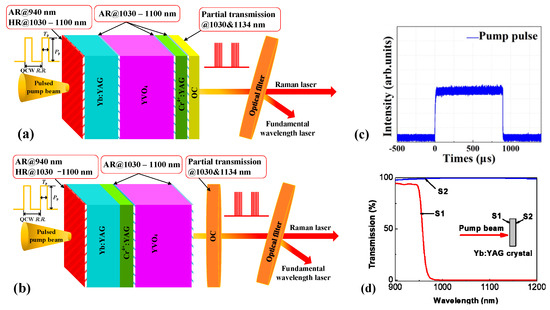
Figure 1
Open AccessCommunication
The Design and Characterization of an Ultra-Compact Asymmetrical Multimode Interference Splitter on Lithium Niobate Thin Film
Photonics 2024, 11(1), 60; https://doi.org/10.3390/photonics11010060 - 05 Jan 2024
Abstract
We propose and demonstrate a high-performance asymmetrical multimode interference splitter on X-cut lithium niobate on insulator (LNOI) with an ultra-compact size of 5.8 μm × (26.4–35.6) μm. A rectangle with a small region is removed from the upper left corner of the multimode
[...] Read more.
We propose and demonstrate a high-performance asymmetrical multimode interference splitter on X-cut lithium niobate on insulator (LNOI) with an ultra-compact size of 5.8 μm × (26.4–35.6) μm. A rectangle with a small region is removed from the upper left corner of the multimode interference (MMI) coupler to achieve a variable splitting ratio. Here, we design and characterize MMIs in six different distribution ratios ranging from 50:50 to 95:5 on a 600 nm thick LNOI. Based on the cascade structure, the linear fitting method accurately shows the device loss (~0.1–0.9 dB). Our fabricated devices demonstrate robustness across a 30 nm optical bandwidth (1535–1565 nm). In addition, we numerically simulate the Z-cut LNOI, showing that the structure corresponding to the TM mode can also achieve a good variable splitting ratio.
Full article
(This article belongs to the Special Issue Photonics Integration on Silicon-on-Insulator and Thin-Film Lithium Niobate Platforms)
►▼
Show Figures
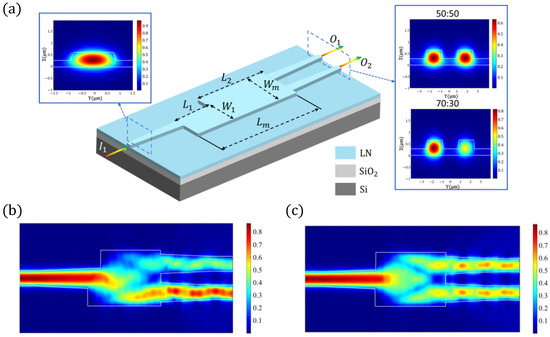
Figure 1

Journal Menu
► ▼ Journal Menu-
- Photonics Home
- Aims & Scope
- Editorial Board
- Reviewer Board
- Topical Advisory Panel
- Instructions for Authors
- Special Issues
- Topics
- Sections & Collections
- Article Processing Charge
- Indexing & Archiving
- Editor’s Choice Articles
- Most Cited & Viewed
- Journal Statistics
- Journal History
- Journal Awards
- Conferences
- Editorial Office
Journal Browser
► ▼ Journal BrowserHighly Accessed Articles
Latest Books
E-Mail Alert
News
Topics
Topic in
Entropy, Photonics, Physics, Plasma, Universe, Fractal Fract, Condensed Matter
Applications of Photonics, Laser, Plasma and Radiation Physics
Topic Editors: Viorel-Puiu Paun, Eugen Radu, Maricel Agop, Mircea OlteanuDeadline: 30 March 2024
Topic in
Drones, Electronics, Land, Photonics, Remote Sensing, Sensors
Hyperspectral Imaging and Signal Processing
Topic Editors: Yinnian Liu, Bing Zhang, Liangpei Zhang, Chenchao Xiao, Yueming Wang, Yongguang Zhang, Qingli Li, Yuwei Chen, Jianxin Jia, Mingyang ZhangDeadline: 31 March 2024
Topic in
Materials, Nanomaterials, Photonics, Polymers, Applied Sciences, Sensors
Optical and Optoelectronic Properties of Materials and Their Applications
Topic Editors: Zhiping Luo, Gibin George, Navadeep ShrivastavaDeadline: 20 May 2024
Topic in
Applied Sciences, JMMP, Materials, Photonics, Plasma
Hybrid and Heterogeneous Integration on Photonic Circuits
Topic Editors: Joan Manel Ramírez, Carlos Alberto Alonso-RamosDeadline: 31 May 2024

Conferences
Special Issues
Special Issue in
Photonics
Photonics in Single Molecule Detection and Analysis Techniques
Guest Editor: Luca NardoDeadline: 20 January 2024
Special Issue in
Photonics
Latest Papers Related to OWPT 2023 on the Topics of Devices, Components and Systems
Guest Editors: Tomoyuki Miyamoto, Motoharu MatsuuraDeadline: 31 January 2024
Special Issue in
Photonics
Time and Frequency Transfer over Fiber Link
Guest Editor: Jianye ZhaoDeadline: 15 February 2024
Special Issue in
Photonics
Microwave Photonic Techniques
Guest Editors: Jianghai Wo, Yuan CaoDeadline: 29 February 2024
Topical Collections
Topical Collection in
Photonics
Advances in 3OM: Opto-Mechatronics, Opto-Mechanics, and Optical Metrology
Collection Editors: Virgil-Florin Duma, Guillermo Garcia-Torales, Tomohiko Hayakawa






